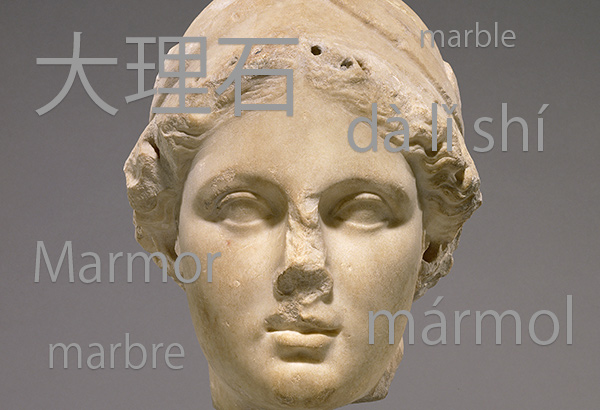
Selected multilingual terms from the entry for marble in the Art & Architecture Thesaurus
The World Wide Web has always aspired to go beyond borders. In fact, it actively works against them.
For those of us engaged in the study of visual arts and cultural heritage, the emergence of the Web has been a provocation. It has forced us to dismantle the false architecture of nationalism by which our field has long been organized. French art, for example, has long been studied as a separate, distinct field from Chinese art. Each is held to have qualities and characteristics that are naturally and essentially different.
Yet cultures have as many similarities as they do differences. And our differences arise not by nature, but by the limitations of our experience of the world. Our world today is large, multiethnic, multilingual, and multipolar. Our dialogue about art and culture must also grow richer and more diverse; it must go beyond borders.
How can we do this? At the Getty, we have been actively working to create and share tools that are both the result of, and a catalyst for, international collaboration. As just three examples, the Getty Research Portal brings together over 38,000 digitized art history publications from libraries around the world; we make hundreds of our own published books available for free as part of our Virtual Library and resource sections for scholars and conservation professionals; and we are working to create Getty Scholars’ Workspace, a digital environment to enable collaborative research among scholars who are geographically separated. All of these efforts are part of our commitment to openly share our resources with the international cultural community.
Great things happen when knowledge is freely shared. As an example, take the recent release of the Getty vocabularies as Linked Open Data—part of our broader Open Content Program. Including records in many languages, the Getty vocabularies are 21st-century reference works (also known as electronic thesauri) for names and terms relevant to art and culture. Last year we began the arduous, and highly collaborative, task of making them available as Linked Open Data. The first two vocabulary databases were released in February and August.
This step has already had powerful results. Last month Europeana, a portal of information and images from more than 2,000 cultural heritage institutions in Europe, began using the Linked Open Data version of the Getty’s Art & Architecture Thesaurus (AAT) to make it easier for users to search and browse its large, varied, multilingual data repository. And we continue to work with several international partners, including the Academia Sinica in Taipei, to make the AAT increasingly multilingual and multicultural. This benefits thousands of users around the world who can now pursue inquiry with greater accuracy, depth, and reach.
Such international collaborations, made possible through technology and strong personal and working relationships among people and organizations, can help us to bridge boundaries in ways that were unimaginable even a decade ago. This is the promise of the digital humanities: to help us better understand and protect the world’s artistic legacy beyond borders of place, language, culture, and imagination.
_______
This post was adapted and shortened from the keynote address delivered at Museum Computing: An Approach to Bridging Cultures, Communities and Science, the 2014 Pacific Neighborhood Consortium (PNC) Annual Conference and Joint Meetings at the National Palace Museum in Taipei, Taiwan, on October 23, 2014.
Download the full address, Beyond Borders, The Humanities in the Digital Age (PDF, 8pp.).




Thank you, Mr. Cuno, for your dedication to the arts and globalism. However, I am worried about the implications of your statement that “our differences arise not by nature, but by the limitations of our experience of the world.” Do you mean to say that if all peoples shared experiences there would be no differences? If an African man goes to the same museums and concerts as you, he will have no differences with you? That’s a disturbing idea, since difference is what makes the world a wonderful place, and museums should celebrate difference, not erase it. People are different because we have different belief systems, values, and world-views developed over centuries. Even if we share experiences, we will see and interpret them differently.
It is not the Web that has made it possible to study French and Chinese art together. Museums have been able to do this for centuries, but unfortunately people in charge of museums have rarely done this, preferring instead to create difference, and there has been little doubt about which cultures they consider superior.
Let’s hope that we don’t need new technology, but rather new arts leaders like yourself, who will change these attitudes and not interpret difference as a product of privilege. In addition to utilizing new technologies, museums can diversify their staffs and encourage different interpretations of art to flourish.
Thank you, Mike, for this very thoughtful comment. My point is that our cultural differences are not natural. We are not born with them. They derive from our experiences. An African man will have had lived experiences very different from mine: how he was raised by his parents, the stories he was told, the food he ate, the songs he sang, the education he received, the political structures he navigated. And these will affect his experience of the museums and concerts he and I have experienced in common.
I agree with you that people have different belief systems, values, and worldviews. My point is simply that people are born with these factors and, should they want to, they can overcome them. And that’s the great beauty of our humanity. We can become more alike than different, if we want to.
Thank you again for taking the time to read this blog post and to respond.